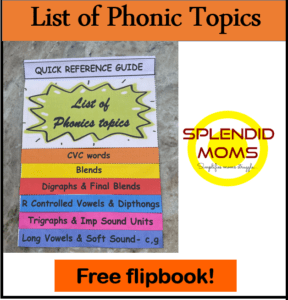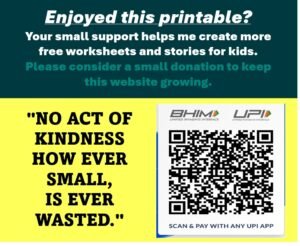List of Phonic Topics - Quick Guide
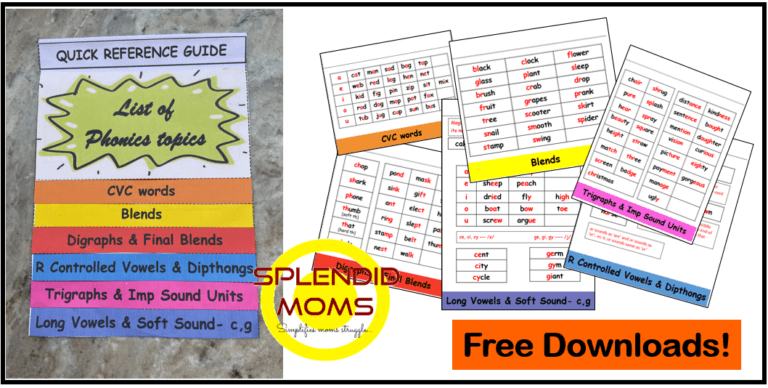
(Disclosure: This post contains affiliate links, which means we may earn a small commission at no extra cost to you if you make a purchase. Thank you for supporting our work!)
Lets talk about the list of phonic topics that are important before learning to read English. We will try to understand how these topics when taught will help your kid in learning to read English.
No idea what to teach after cvc words or the three letter words? here are the list of phonic topics that are important to learn reading English words and sentences.
You can download the free phonics flip book at the end of this page for quick revision of phonics to your child.
Phonic Topics
- CVC Words
- Blends
- Digraphs
- Final blends
- R Controlled Vowels
- Dipthongs
- Long Vowel Sounds
- Trigraphs
- Few More Sount Units
Lets learn about each one of them briefly:
CVC Words:
Just after teaching Letter sounds introduce vowels. The 5 vowels and their sounds are very important as it will help in word pronunciation.
CVC words help introduce children to reading by first learning the sounds of the individual letters, then blending of vowels with consonants. Apart from blending also teach segmenting of sounds from a cvc or 3 letter word. Segmenting means to identify individual sound in word. Identifying beginning, middle, end sound are a part of learning CVC words.
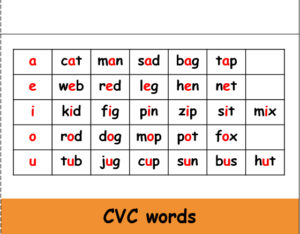
Blends:
Blends refer to two consonant that appear at the beginning of a word, such as bl-, br-, cl-, cr-, fl-, etc. These two consonant sounds are blended to read them together.

Digraphs:
A digraph is two letters that make one sound. The digraph can be made up of vowels or consonants.
There is difference between a blend and a digraph. In a blend, each letter retains its individual sound. For example, in the word crab, you can still hear the individual /c/ and /r/ sounds in the “cr” blend. This is different from a digraph. A digraph is a two-letter combination that represents a single sound like ch in chip.
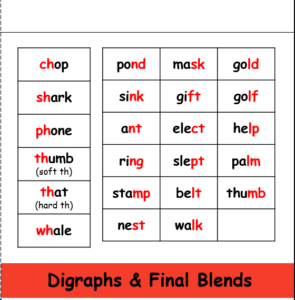
Final Blends
Like beginning blends here is the list of some important and frequent final blends.
R controlled vowels.
An r-controlled vowel is any vowel followed by letter r. The r changes the sound that vowel makes. R controlled vowels are often called “Bossy R” because the r takes over and makes the vowel make a new sound. The er, ir, and ur all make the same sound /er/ as in her, bird, and fur. Ar usually makes the sound in far. Or usually makes the sound in nor.

Dipthongs:
two vowel sounds that are pronounced together to make one sound, for example the ou sound in ‘house’
Long Vowel Sounds:
Vowels have short and long sound.Long vowel sounds are vowels that are pronounced the same as their name.Long vowels are very common but they can be tricky because there are so many spellings for each long vowel sound. And unfortunately there are hardly any rule which tells which one to use.
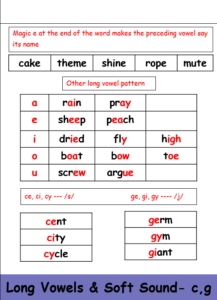
Trigraphs:
Trigraph is a group of three letters representing one sound, for example air, tch etc. Trigraphs can consist of all consonants, a mixture of consonants and …vowels.
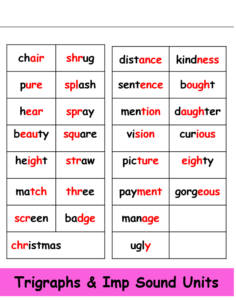
Important Sound Units:
Few more spelling patterns that are common are listed here. Learning them will help in reading bigger words.
Apart from these phonic topics, include sight words in the reading practice. As 75% – 80% of English sentences has sight words , learning them boost the confidence of the reader and improves their fluency.
Just Phonics Box Set – A Fun Start to Phonics for Ages 3–5
Teaching phonics at home doesn’t have to feel overwhelming—especially with the Just Phonics Box Set of 4 Books, Brain Boosting Activity Book, and Early Learning Combo Set. Specially designed for children aged 3–5, this set takes your child step by step from learning the 26 letter sounds to the full range of 42 phonics sounds. Using a multi-sensory, spiral approach, the books help little learners not only hear but also see and practice the shape and formation of each sound, making recognition natural and easy. One of the biggest advantages for parents is that blending of simple CVC words is introduced early, so your child can quickly begin to read real words with confidence. Moving from Junior Infants to Senior Infants, these books provide a complete path for early reading success—making phonics fun, effective, and easy to teach at home. I personally recommend this set for parents who want to give their children a strong start in reading.
- Phonics Sound Book for children
- Phonics books for 2-3 year old
- Junior Infants (26 letter sounds) helps in self correction.
What’s more, parents have the flexibility to purchase these books individually depending on their child’s stage and learning needs. Whether you’re just beginning with letter sounds, focusing on blending, or ready to advance to more complex phonics, you can choose the exact book that fits your child’s level—making phonics teaching both affordable and adaptable.
- Just Phonics (26 Letter Sounds) and Activity Books follow the letter and Sound Sequence class Junior Infants.
- Just Phonics Activity Book (Education primary Phonics Programme) and follow the letter and Sound Sequence(Senior Infants))
- Just Phonics book for kids for 5 years (Education primary Phonics Programme Class 1st) and follow the letter and Sound Sequence
- Just Phonics: Brain Boosting Activity Book Class 2nd, Match the Pair, Find the Difference, Maze, Crossword


